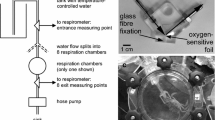Summary
Comparison of Cartesian Diver-Winkler measurements of respiratory rates in larvae of the damselfly Pyrrhosoma nymphula, and Cartesian Diver-Gilson comparisons in the snail Potamopyrgus jenkinsi are descibed. Measurements of oxygen uptake using these different methods do not differ significantly for the same species of animal at the same temperature. Published data likewise suggest that Warburg and Winkler measurements can give similar results.
All these methods, therefore, appear to be equally suitable for ecological work, providing they are used carefully and with a sound knowledge of the biology of the animal under investigation.
Similar content being viewed by others
References
Allee, W. C., Oesting, R.: A critical examination of Winkler's method for determining dissolved oxygen in respiration studies. Physiol. Zool. 7, 509–541 (1934).
Carpenter, J. H.: The accuracy of the Winkler method for dissolved oxygen analysis. Limnol. Oceanogr. 10, 135–140 (1965 a).
— The Chesapeake Bay Institute technique for the Winkler dissolved oxygen analysis. Limnol. Oceanogr. 10, 141–143 (1965b).
Carritt, D. E., Carpenter, J. H.: Comparison and evaluation of currently employed modifications of the Winkler method for determining dissolved oxygen in seawater. A NASCO Report. J. Mar. Res. 24, 286–318 (1966).
Fox, H. M., Wingfield, C. A.: A portable apparatus for the determination of oxygen dissolved in a small volume of water. J. exp. Biol. 15, 437–445 (1938).
Gilson, W. E.: Differential respirometer of simplified and improved design. Science 141, 531–532 (1963).
Klekowski, R. Z.: Cartesian Diver technique for micro-respirometry. Technical Meeting on methods of Assessment of Secondary Production in Freshwaters: IBP-PF, Liblice, Prague, 26 pp., April 1967.
Lawton, J. H.: Studies on the ecological energetics of damselfly larvae (Odonata: Zygoptera). Ph. D. thesis, University of Durham (1969).
Pearcy, W. G., Theilacker, G. H., Lasker, R.: Oxygen consumption of Euphausia pacifica: the lack of a diel rhythm or light-dark effect, with a comparison of experimental techniques. Limnol. Oceanogr. 14, 219–223 (1969).
Richman, S.: The transformation of energy by Daphnia pulex. Ecol. Monogr. 28, 273–291 (1958).
Umbreit, W. W., Burris, R. H., Stauffer, J. F.: Manometric techniques, 4th ed. Minneapolis: Burgess Publ. Co. 1964.
Zeuthen, E.: Cartesian diver respirometer. Biol. Bull. 98, 139–143 (1950).
Author information
Authors and Affiliations
Rights and permissions
About this article
Cite this article
Lawton, J.H., Richards, J. Comparability of Cartesian Diver, Gilson, Warburg and Winkler methods of measuring the respiratory rates of aquatic invertebrates in ecological studies. Oecologia 4, 319–324 (1970). https://doi.org/10.1007/BF00377251
Received:
Issue Date:
DOI: https://doi.org/10.1007/BF00377251




